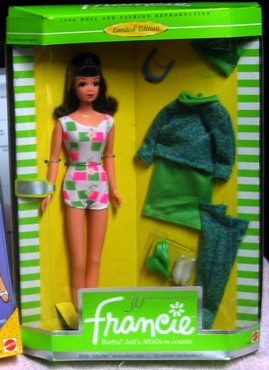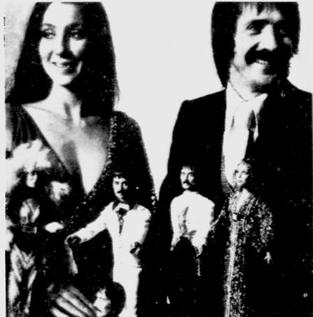
Barbie is a fashion doll created by American businesswoman Ruth Handler, manufactured by American toy and entertainment company Mattel and introduced on March 9, 1959. The toy is the figurehead of an eponymous brand that includes a range of fashion dolls and accessories. Barbie has been an important part of the toy fashion doll market for over six decades. Mattel has sold over a billion Barbie dolls, making it the company's largest and most profitable line. The brand has expanded into a multimedia franchise since 1984, including video games, computer-animated films, television/web series, and a live-action film.

Margaret "Midge" Hadley Sherwood is a doll character in the Barbie line of toys by Mattel that was first released in 1963. She was marketed as Barbie's best friend.

Ruth Marianna Handler was an American businesswoman and inventor. She is best known for inventing the Barbie doll in 1959, and being co-founder of toy manufacturer Mattel with her husband Elliot, as well as serving as the company's first president from 1945 to 1975.
John W. Ryan was an American designer. Ryan worked at toy company Mattel for 20 years, becoming the company's vice president of research and development, and subsequently working as a consultant. He was responsible for the Barbie doll, Hot Wheels, and Chatty Cathy. He was the sixth husband of actress Zsa Zsa Gabor.

Skipper Roberts is a doll created by Mattel in 1964 to be Barbie's younger sister.
Polly Pocket is a toy line of dolls and accessories first founded and designed by Chris Wiggs in 1983 and licensed by Bluebird Toys from 1989 until both entities/properties were acquired by Mattel in 1998.
Chatty Cathy is a pull-string "talking" doll originally created by Ruth and Elliot Handler and manufactured by the Mattel toy company from 1959 to 1965. The doll was first released in stores and appeared in television commercials beginning in 1960, with a suggested retail price of $18.00, though usually priced under $10.00 in catalog advertisements. Chatty Cathy was on the market for six years and was the second most popular doll of the 1960s after Barbie.
Totally Hair Barbie is a fashion doll, in the Barbie line by Mattel, that was released in 1992. The doll's extra-long hair reached all the way to her toes and at the time, she had the longest hair ever for a Barbie doll at 11.5 inches in length. She is notable for being the highest selling Barbie doll in history.

Fashion dolls are dolls primarily designed to be dressed to reflect fashion trends. They are manufactured both as toys for children to play with and as collectibles for adults. The dolls are usually modeled after teen girls or adult women, though child, male, and even some non-human variants exist. Contemporary fashion dolls are typically made of vinyl or another plastic.

What's Her Face! was a line of customizable dolls that straddled the line between traditional fashion dolls and creative activity toys. Made by Mattel, the line ran from 2001–2003, and enjoyed only a modest success in a market dominated by Mattel's iconic Barbie and MGA Entertainment's Bratz dolls. Following the discontinuation of the What's Her Face! line, their body molds were used for the Wee 3 Friends line of Barbie-related dolls. Several fashion, wig, and activity packs were also released for the What's Her Face line.

My Scene is an American series of fashion dolls that Mattel released in 2002. They were discontinued in the US in 2008, and worldwide in 2011. Mattel's Barbie character is one of the dolls in the toy line. The My Scene dolls' bodies are slim, similar to earlier Barbie dolls, but their heads are larger. The New York Times described their features as "exaggerated lips and bulging, makeup-caked eyes." My Scene were designed to appeal to the tween market and compete with the Bratz dolls from MGA Entertainment.

Francie Fairchild is a fashion doll issued by Mattel from 1966 to 1976 and re-introduced in 2011. Marketed as "Barbie's MODern cousin" from England, the doll had an extensive line of "mod"-style clothing, often employing bright colors and geometric patterns similar to fashions associated with Carnaby Street in the late 1960s to early 1970s. At 11¼ inches tall, the Francie doll was shorter than Barbie, but taller than Skipper, making the character presumably between the two in age.
Tressy was an American fashion doll with a feature to adjust the length of its hair. Tressy was first produced by American Character Doll Company in the 1960s and later by Ideal Toy Company in the 1970s. The doll was invented and patented by modern furniture designer Jesse Dean and his wife, Diana.
Earring Magic Ken, also known as "Gay Ken" and "Fey Ken", is a model of the Ken doll introduced by Mattel in 1993 as a companion to its Earring Magic Barbie figure, one of five dolls in the Earring Magic Barbie line.

The Sonny & Cher dolls were a collection of 12-¼ inch high celebrity doll likenesses of pop rock duo Sonny & Cher. The line was released by Mego Corporation in 1976. The release of these fashion dolls coincided with the popularity of The Sonny & Cher Show prime time variety TV show.
Princess of Power is a toyline created by Mattel. Among others, it features the characters of She-Ra and Catra on planet Etheria. With its launch in 1984, the toyline spawned a variety of products, including three lines of fashion action figures. The Princess of Power logo and characters are currently used by Mattel as part of the Masters of the Universe Classics toyline.
The Barbie Basics is a line of collector's edition Barbie dolls. They were created by Mattel designer Bill Greening and were introduced in late 2009 to be officially released in the spring of 2010.
The American Character Doll Company was an American toy company specializing in dolls. Their most popular dolls included "Tiny Tears," "Tressy," "Butterball Doll", "Sweet Sue," and "Toodles." Founded in 1919, the company's fortunes peaked in the mid-20th century, as they sold millions of dolls exclusively to retailers and mail-order houses such as Sears and Montgomery Ward. The company was the first to produce mass-marketed rubber dolls in the United States. American Character Dolls went bankrupt in 1968, with their assets acquired by the Ideal Toy Company.
Lilli, also known as Bild-Lilli, is a discontinued West German comic strip created by Reinhard Beuthien for the tabloid newspaper Bild, appearing there from 1952 to 1961.








